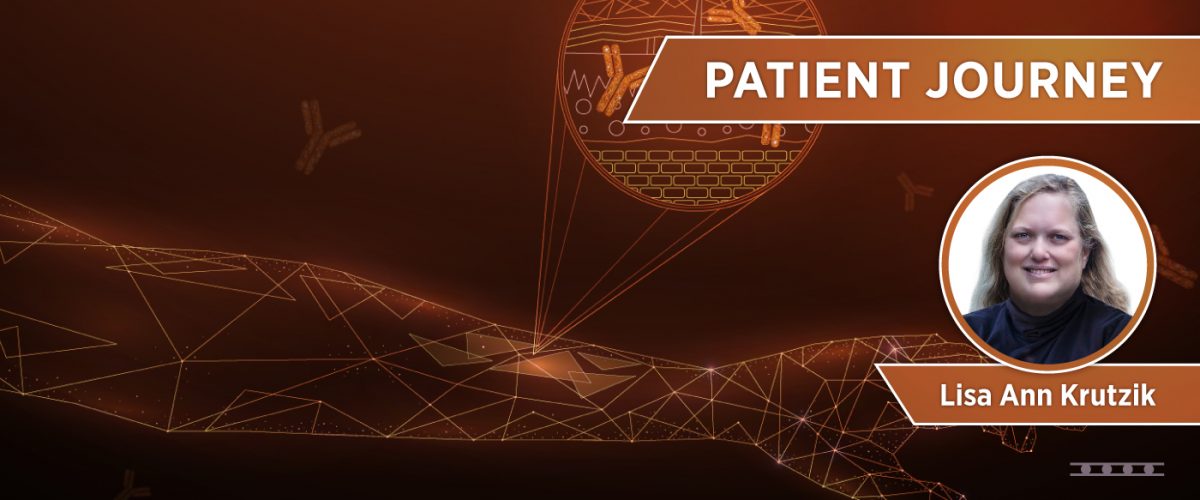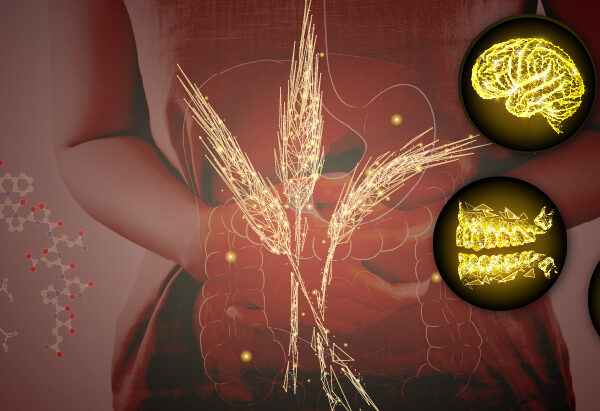Before the Diagnosis
Lisa Ann lived a routine life, working at a Recreational Vehicle (RV) dealership where she interacted with customers, taught them how to use RVs, and made sure she helped every customer in need. One day in mid-2016, she woke up with a sore throat without any potential causes. She did not feel sick but felt that something was constantly stuck in her throat, causing her to persistently cough, in an effort to clear her throat. Her salivary glands were extremely swollen, swallowing became unbearable, and she could no longer speak making it nearly impossible to communicate and perform her daily activities with customers at the RV dealership.

Figure 1 Lisa Ann has lived near Buffalo, NY since 2012. Photo taken in March 2020, prior to making healthy lifestyle changes.
The first doctor she visited believed she had a lesion in her throat that could have resulted from eating spicy chicken wings. Living in Buffalo, New York, eating buffalo wings wasn’t a first for Lisa Ann, but she had never experienced symptoms like this before. The following doctor she consulted was with a primary care physician who believed she had herpes simplex virus (HSV). Upon visiting a third doctor, an ear, nose, and throat (ENT) specialist due to her persistent symptoms, she received a similar diagnosis of a severe form of HSV. By then, Lisa Ann felt humiliated, frustrated and was still in excruciating pain. She felt that something was seriously wrong with her body and that it could not have been caused by HSV.

Figure 2. Although this clinical presentation is not indicative of HSV, this autoimmune skin blistering condition was misdiagnosed for it by two physicians Lisa Ann visited.
Fighting an Unknown Battle
One hot, sunny day in August 2016, Lisa Ann was out in a vineyard planting grapevines and taking pictures. She returned home with a terrible sunburn which started off as a blister. Blisters following a severe sunburn often burst and release a small pocket of body fluid (i.e., serum, blood, or pus) which caused her skin to become completely raw. The blistering appeared under her arms, breasts, stomach and mouth. Upon visiting another doctor, the only diagnosis she received was that it was a possible heat rash. Unfortunately, the pain and disfiguring appearance of her skin continued to worsen.
Due to the uncertainty and persistent aggravation of her condition, her doctor recommended she visit a rheumatologist or an infectious disease (ID) specialist. “Fix me”, Lisa Ann helplessly exclaimed to her ID specialist. Two weeks later, he couldn’t diagnose her condition but did note that it wasn’t infectious. Although this was a relief to Lisa Ann, she still had no clear explanation of why these painful blisters were appearing. The ID specialist referred her to a dermatologist to at least help with the blistering and the loss of fluids she was experiencing.
Unbeknownst to her, the blistering was not a result of sun exposure. In reality, Lisa Ann’s body was producing antibodies that attacked her skin. By now, her body was attacking its own proteins on her skin resulting in the continuous erosion of her skin. Every day spent without a proper diagnosis resulted in her body’s immune system completely collapsing, and ultimately worsening her clinical condition.
Pemphigus Vulgaris: A Condition Only Seen in Textbooks
On October 12, 2016, Lisa Ann went into her dermatology appointment. She was greeted by a dermatology physician assistant (PA) who took one look at her and said, “I think I know what’s wrong with you, but I’ve only seen it in textbooks.” The PA continued “I think you have a rare autoimmune skin disease called Pemphigus Vulgaris (PV)” and subsequently requested for a biopsy and other diagnostic tests to confirm her potential diagnosis. This rare autoimmune skin condition caused autoantibodies to interfere with the proteins that bind the cells of the epidermis (top layer of skin), called desmogleins.1 When desmogleins are attacked, the skin cells separate leading to the erosion of the skin.1
The PA explained that the University of Buffalo had two doctors who specialized in autoimmune dermatology. While waiting for the final diagnosis, Lisa Ann had done her own research online and came across one Dr. Animesh Sinha. Dr. Animesh Sinha is a widely renowned autoimmune dermatologist at University at Buffalo Jacobs School of Medicine and Biomedical Sciences. Dr. Sinha has over 30 years of experience in immunology and dermatology. He holds both an MD and PhD with the goal of bridging the bench to the bedside. Lisa Ann took matters into her own hands and emailed Dr. Sinha to request for an appointment. Fortunately, and to her surprise, she received an appointment that same week.
7 Doctors. 7 Months. 70 Pounds Lost.
This is what it took for Lisa Ann to finally receive an accurate diagnosis. The biopsy confirmed she had PV. PV affects individuals of all races and sexes but is typically seen in adults between 40 to 60 years of age.2 Just like in the textbooks, Lisa Ann began to experience symptoms in her late 40s. Dr. Sinha took the time to speak with Lisa Ann and provide her the care and comfort she had yearned for. Despite being an extremely rare condition, with an estimated prevalence of 0.1 and 2.7 per 100,000 people per year2, for the first time, she felt like she was not alone. By this time, she had been introduced to the International Pemphigus and Pemphigoid Foundation (IPPF) which helped her to get engaged and be part of a support system involving patients with similar conditions.
Dr. Sinha prescribed systemic corticosteroids (i.e., prednisolone or equivalent therapies) which remain the gold standard treatment for PV.3 One of the main concerns with PV is the rapid and uncontrolled progression many patients face. With corticosteroids, there is more control of disease activity and a reduction in inflammatory response as well as autoantibody production.3 Dr. Sinha also discussed possibly enrolling Lisa Ann in a clinical trial for rituximab (MabThera®, Rituxan®). As of June 2018, the Food & Drug Administration (FDA) has approved rituximab for treatment of moderate to severe PV.4 Rituximab is an anti-CD20 monoclonal antibody and is the first biologic therapy approved by the FDA for PV treatment in over 60 years.4 Rituximab is recommended to be used in combination with a tapering course of corticosteroids and helps patients achieve complete remission (at 24 months without the use of steroids for 2+ months).4,5

Figure 3. In 2020, Lisa Ann embarked on an extremely healthy eating plan to control inflammation and has lost over 100 pounds since her heaviest weight prior to getting sick. After multiple years of various treatments, some weight piled back on…but the joy of being blister free has made reality bearable. Photo taken in June 2021.
The Beginning of a New Journey
After months of misdiagnosis and countless doctor visits, Lisa Ann was finally on the right track to recovery with an accurate diagnosis and a coherent treatment plan. Since then, Lisa is involved with many Facebook support groups where she connects with patients or caregivers all around the world impacted by pemphigus disorders.
“I am not the person that I was [before PV] …and that’s okay”, Lisa Ann states. She has chosen to live a more physically, mentally healthy, and mindful lifestyle. Despite tiny blisters that may form on her mouth or skin, Lisa Ann is in remission without any pharmaceutical aid. In her new lifestyle, she rides a motorcycle and lives with the mantra “Live every day to the fullest.” With increasing disease awareness and with improved rapid and accurate diagnostic tests for autoimmune dermatology, there is hope for patients like Lisa Ann suffering from autoimmune dermatology conditions.

Figure 4. Lisa Ann now rides a motorcycle and continues to live life to the fullest. This photo shows Lisa Ann with her dream bike.
Lab Testing Methods & Patient Resources
EUROIMMUN is the world leader in the field of autoimmune diagnostics with a large portfolio in dermatology. Using ELISA and IIFT techniques, clinicians can test for desmoglein 3, desmoglein 1, envoplakin, and other bullous pemphigoid antigens (i.e., BP180, BP230, laminin 332) to aid in a rapid and accurate diagnosis for patients with any pemphigus diseases.
To learn more about autoimmune skin blistering diseases, register for the second episode of EUROIMMUN Academy’s Dermatology Webinar Series featuring Dr. Animesh Sinha from University of Buffalo who played a crucial role with Lisa Ann and her journey. If you are a patient or caregiver interested in support groups and additional patient resources, please contact IPPF for more information.

Figure 5. Lisa Ann (top left with gray/blue scarf) at Rare Disease Week on Capitol Hill
Patient story and images: courtesy of Lisa Ann
References
- Center GaRDI. Pemphigus vulgaris. https://rarediseases.info.nih.gov/diseases/7355/pemphigus-vulgaris. Published 2018. Updated June 22, 2018. Accessed July 1, 2021, 2021.
- Foundation IPP. Pemphigus: Who gets it? https://www.pemphigus.org/pemphigus/. Accessed July 1, 2021, 2021.
- Gregoriou S, Efthymiou O, Stefanaki C, Rigopoulos D. Management of pemphigus vulgaris: challenges and solutions. Clin Cosmet Investig Dermatol. 2015;8:521-527.
- Genentech. https://www.gene.com/media/press-releases/14727/2018-06-07/fda-approves-genentechs-rituxan-rituxima. https://www.gene.com/media/press-releases/14727/2018-06-07/fda-approves-genentechs-rituxan-rituxima. Published 2018. Updated June 7, 2018. Accessed July 8, 2021.
- Frampton JE. Rituximab: A Review in Pemphigus Vulgaris. American Journal of Clinical Dermatology. 2020;21(1):149-156.





